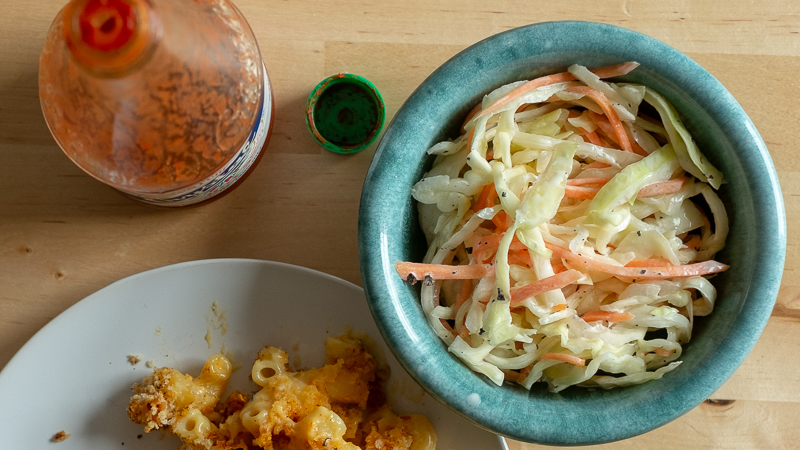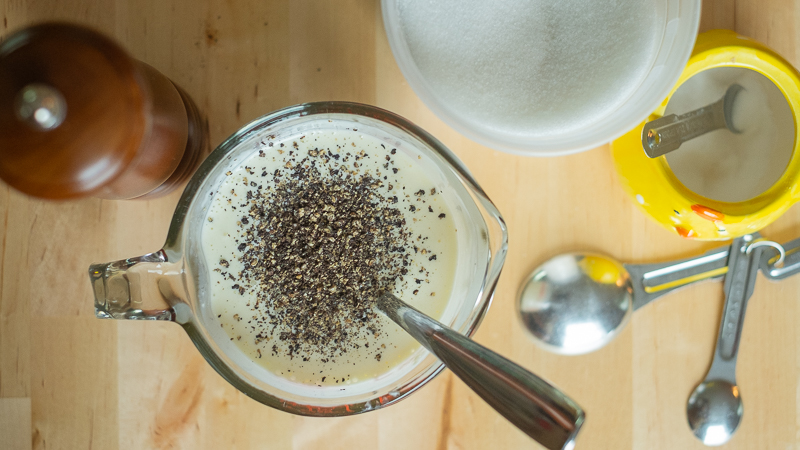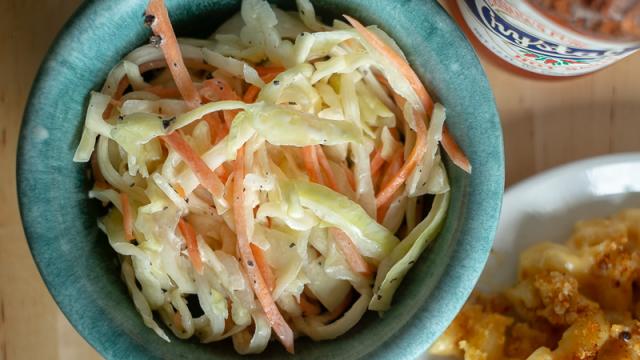During any weekend dinner party or barbecue night you can almost guarantee it: Somebody is going to bring a bowl of terrible coleslaw to your home, and you’re going to have to pretend you like it.
As one of the dozens of people — dozens! — who love a good slaw, barbecues are usually an exercise in disappointment. Too often, coleslaw is the last item claimed on a potluck spreadsheet and the only buffet-table offering still untouched at sundown; in other words, a total afterthought. I can see why: raw cabbage swimming in sugared mayonnaise is, conceptually, pretty foul. But as with so much in life, a little respect for the process and ingredients is all it takes to make a star out of this unfairly neglected side dish.
Well, a little respect — and plenty of salt. With over-sugared, under-salted coleslaw is everywhere, my number one coleslaw tip is to use more salt than you think you need. Apart from that, here are a few other guidelines to set you on the right path:
- Don’t overcomplicate things. You wanna get a little wild, pal? Have an urge to throw in some pineapple or red cabbage, or maybe a zesty chipotle dressing like it’s 2009? Stop. Respect and master the barest, simplest form of coleslaw before you start riffing on it.
- Don’t make it ahead. Some salads get better the longer they sit. Coleslaw very much does not. If your schedule necessitates advance prep, transport the vegetables and dressing to their final destination separately and assemble just before serving.
- Don’t grate your carrots. Grated carrots are wet, they’re gross, and they have no place in coleslaw. Please, I’m begging you: julienne your carrots. If you struggle with this technique, watch Maangchi do it (her bias-sliced method changed the game for me) or buy a julienne peeler.
- Pre-shredded vegetables are fine. Not everyone has the time or inclination to break down a head of cabbage or julienne carrots, and that’s OK. Bagged mix is perfectly respectable — just don’t let it sit in your fridge for more than a couple of days.
- Pre-made dressing is not fine. Coleslaw needs a lot of seasoning in order to taste good, and bottled dressing never quite gets the job done. Homemade dressing is dead simple and tastes better.
A list of tips is nice and all, but the easiest way to make coleslaw that doesn’t suck is to use a good recipe — so I finally transcribed mine, just for you. If you’ve been tasked with bringing coleslaw to this year’s Memorial Day get-together, this is a great place to start.
Very Good Coleslaw

This yields about six cups of dressed slaw, which will feed six to eight adults. If you’re using pre-shredded veggies, two sixteen-ounce bags sub in nicely for the cabbage and carrots. You may or may not use every last drop of dressing; any leftovers are great with crudités. Finally, keep in mind that I use table salt.
Ingredients
For the dressing:
- Generous ¼ cup mayonnaise
- Generous ¼ cup sour cream
- ¼ cup apple cider vinegar (or distilled white vinegar)
- 1 tsp. table salt, heaped, plus more to taste
- 2 tsp. granulated sugar, plus more to taste
- 1-2 tsp. celery seed (optional)
- Freshly cracked black pepper (optional)
For the salad:
- Half a head of green cabbage (680 g.)
- One large or two small carrots (170 g.)
- Half a small onion, or a quarter of a medium one (40 g.)
- ¼ tsp. table salt
Instructions:
First, make the dressing: mix all ingredients in a pourable container, taste, and adjust seasoning as needed. (The dressing should be so potent that eating it straight from the spoon is a borderline unpleasant experience, so really have at it with the salt and sugar.) Prepared dressing keeps in the fridge for three days or so.

Make the salad: if you haven’t already, split a green cabbage in half lengthwise and peel off any sad, withered outer leaves. Shred finely with a sharp knife. I do this by making two opposing diagonal cuts at the top of the head and following those cuts with my knife, alternating between the two sides, until I reach the core. Cabbage cores are definitely good enough to eat, but mine was a little sad, so I skipped it this time. (It was an old cabbage.)
Place the shredded cabbage in a large bowl. Peel and julienne the carrots; add to the bowl. Shave the onion crosswise into half-moons and throw those in, too. Sprinkle the vegetables with a quarter teaspoon of salt and toss to distribute.
If you’re serving the coleslaw immediately, stir in the dressing little by little until everything is nicely coated; chopsticks work great for this. You might not need all of the dressing, so take it easy and taste as you go.
If you’re not serving the coleslaw for a few hours, turn the vegetables out onto a rimmed baking sheet lined with kitchen or paper towels. Rest at room temperature for ten minutes, then gently blot off as much water as you can with another layer of towels. (If you have one, a salad spinner works great for this step.) Transfer the vegetables to a clean, dry bowl, cover, and refrigerate for up to 24 hours. If more water leaches out during refrigeration, drain, blot, or spin it off before adding the dressing.
Anyone who loves coleslaw — or is on the fence about it — is going to love this recipe. It’s simultaneously creamy and tangy, with enough salt to counter the bitterness of raw cabbage and enough sweetness to be completely addictive. I’m not saying it will make a convert of every slaw-hater it meets, but it might just change a few minds.

Comments
One response to “Stop Making Bad Coleslaw”
Ok ok. I’ll stop.
Geezuz.